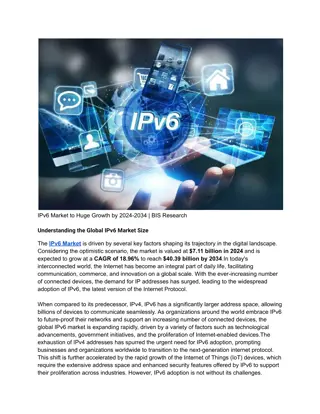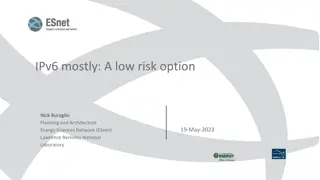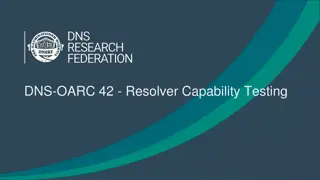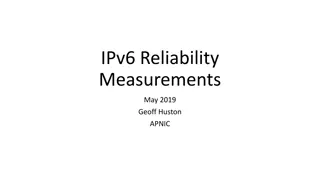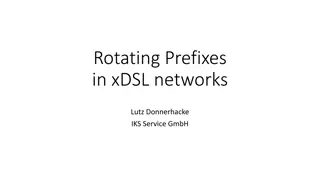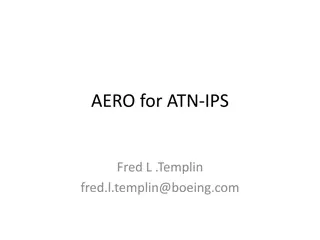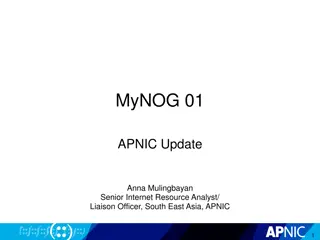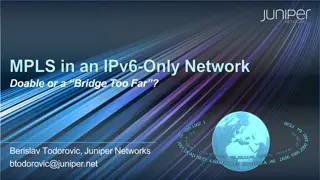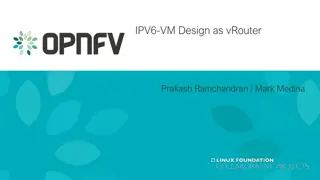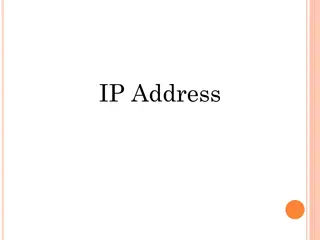
Understanding IPv4 and IPv6 Networking Basics
Explore the fundamental differences between IPv4 and IPv6 addressing, NAT types, and autoconfiguration protocols. Learn about the historical development, header comparisons, and interface identifier generation techniques in IPv6. Dive into the world of network addressing and routing protocols to grasp the evolution and functionalities of IPv4 and IPv6.
Download Presentation

Please find below an Image/Link to download the presentation.
The content on the website is provided AS IS for your information and personal use only. It may not be sold, licensed, or shared on other websites without obtaining consent from the author. If you encounter any issues during the download, it is possible that the publisher has removed the file from their server.
You are allowed to download the files provided on this website for personal or commercial use, subject to the condition that they are used lawfully. All files are the property of their respective owners.
The content on the website is provided AS IS for your information and personal use only. It may not be sold, licensed, or shared on other websites without obtaining consent from the author.
E N D
Presentation Transcript
IPv6 Minsoo Jin & Alex Kornilenko
IP Main Jobs Addressing Hosts Routing
IPv4 Current : RFC-791 (1981) Prev: RFC-760 (1980) Range: 0.0.0.0 : 255.255.255.255 Supports: 2^32 || 4.3 * 10 ^ 9
NAT (Network Address Translation) Full Cone NAT Restricted Cone NAT Port Restricted Cone NAT Symmetric NAT
IPv6 Formally: RFC-2460 (1998) Range: 0000:0000:0000:0000:0000:0000:0000:0000 FFFF:FFFF:FFFF:FFFF:FFFF:FFFF:FFFF:FFFF Supports: 2^128 || 3.4 * 10 ^ 38 Visual IPv4: 4,300,000,000 Visual IPv6: 340,000,000,000,000,000,000,000,000,000,000,000,000
Stateless Address autoconfiguration Described in RFC2462 Eliminates the need for DHCP Allows hot plugging of network devices Smaller overhead
Stateless Address autoconfiguration -Steps 1)Link-Local Address Generation a) Link-Local : 1111111010 + 50 * 0 + 64 bit interface identifier 2)Link-Local Address Uniqueness Test 3)Link-Local Address Assignment 4)Router Contact 5)Router Direction 6)Global Address Configuration
IPv6 Interface Identifiers RFC 2373: Identifier is derived from (EUI)-64 address RFC 3041: Randomly-generated
Stateless Address autoconfiguration -Steps (Continue) 1)Link-Local Address Generation a) Link-Local address : 1111111010 + 50 * 0 + 64 bit interface identifier 2)Link-Local Address Uniqueness Test 3)Link-Local Address Assignment 4)Router Contact 5)Router Direction 6)Global Address Configuration a) Global Unique Address
Unicast, Multicast and Anycast Addresses Unicast : One to One Multicast : One/Many to Many Anycast : Many to Few
IPv6 Address Types https://www.ripe.net/participate/member-support/new-lir/ipv6_reference_card.pdf
IPv4 and IPv6 Direct Communication No direct Communication :(
IPv6 Consumer Switch In order to use ipv6, 3 things must be true: -your machine must support ipv6 -your home network must support ipv6 (your router) -your isp provider must support ipv6
IPv6 ISP Switch Per-Country IPv6 adoption in July 2015 Source: Google
Per-Country IPv6 adoption in Jan 2016 Source: Google
Top 25 internet service providers for IPv6 in Canada (Nov 2015) (IPv6 tests count) 1.Hurricane Electric (1,159) 2.Peer 1 Network (USA) Inc. (597) 3.gogo6 Inc. (573) 4.TELUS Communications Inc. (539) 5.Canada Web Hosting (521) 6.TekSavvy Solutions (383) 7.Rogers Cable Communications Inc. (298) 8.Le Groupe Videotron Ltee (228) 9.Start Communications (168) 10.Amanah Tech Inc. (86) 11.OVH Hosting (58) 12.COGECO Cable Canada Inc. (53) 13.Bell Mobility Inc. (50) 14.Cogeco Cable Inc. (44) 15.Rogers Communications Partnership (33) 16.TekSavvy Solutions Inc. (32) 17.Futureway Communications Inc. (31) 18.Team Cymru Inc. (26) 19.Electronic Box (18) 20.University of Waterloo (16) 21.Bell Canada (16) 22.American Registry Internet Numbers (16) 23.Shaw Communications Inc. (13) 24.Canarie Inc (13) 25.Cogent Communications (13) source: http://ipv6-test.com/stats/country/CA
Teredo (Shipworm) Service provides IPv6 connectivity to nodes located behind one or more IPv4 NATs tunnels IPv6 packets over the User Datagram Protocol (UDP) through NAT devices Teredo tunnels use Teredo servers and Teredo relays The Teredo servers are stateless, and manage a small fraction of the traffic between Teredo clients, while the Teredo relays act as IPv6 routers between the Teredo service and the native IPv6 Internet
IPv6 using Tunnel Brokers (demo) 1.Hurricane Electric 2.gogo6


